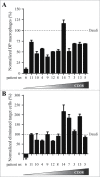Antibody-mediated phagocytosis contributes to the anti-tumor activity of the therapeutic antibody daratumumab in lymphoma and multiple myeloma
- PMID: 25760767
- PMCID: PMC4622648
- DOI: 10.1080/19420862.2015.1007813
Antibody-mediated phagocytosis contributes to the anti-tumor activity of the therapeutic antibody daratumumab in lymphoma and multiple myeloma
Abstract
Daratumumab (DARA) is a human CD38-specific IgG1 antibody that is in clinical development for the treatment of multiple myeloma (MM). The potential for IgG1 antibodies to induce macrophage-mediated phagocytosis, in combination with the known presence of macrophages in the tumor microenvironment in MM and other hematological tumors, led us to investigate the contribution of antibody-dependent, macrophage-mediated phagocytosis to DARA's mechanism of action. Live cell imaging revealed that DARA efficiently induced macrophage-mediated phagocytosis, in which individual macrophages rapidly and sequentially engulfed multiple tumor cells. DARA-dependent phagocytosis by mouse and human macrophages was also observed in an in vitro flow cytometry assay, using a range of MM and Burkitt's lymphoma cell lines. Phagocytosis contributed to DARA's anti-tumor activity in vivo, in both a subcutaneous and an intravenous leukemic xenograft mouse model. Finally, DARA was shown to induce macrophage-mediated phagocytosis of MM cells isolated from 11 of 12 MM patients that showed variable levels of CD38 expression. In summary, we demonstrate that phagocytosis is a fast, potent and clinically relevant mechanism of action that may contribute to the therapeutic activity of DARA in multiple myeloma and potentially other hematological tumors.
Keywords: ADCC, antibody-dependent cellular cytotoxicity; BL, Burkitt's lymphoma; BM, bone marrow; Burkitt's lymphoma; CCS, cosmic calf serum; CD38; CDC, complement-dependent cytotoxicity; DARA, daratumumab; DP, double positive; E:T, effector to target ratio; FcγR, Fc-gamma receptor; IMiD, immunomodulatory drug; MM, multiple myeloma; MNC, mononuclear cells; Mϕ, macrophage; PBMC, peripheral blood mononuclear cells; daratumumab; mAb, monoclonal antibody; macrophage; multiple myeloma; phagocytosis; therapeutic antibody.
Figures





References
-
- Manches O, Lui G, Chaperot L, Gressin R, Molens JP, Jacob MC, Sotto JJ, Leroux D, Bensa JC, Plumas J. In vitro mechanisms of action of rituximab on primary non-Hodgkin lymphomas. Blood 2003; 101:949-54; PMID:12393572; http://dx.doi.org/10.1182/blood-2002-02-0469 - DOI - PubMed
-
- Munn DH, McBride M, Cheung NK. Role of low-affinity Fc receptors in antibody-dependent tumor cell phagocytosis by human monocyte-derived macrophages. Cancer Res 1991; 51:1117-23; PMID:1825476 - PubMed
-
- Mantovani A, Schioppa T, Porta C, Allavena P, Sica A. Role of tumor-associated macrophages in tumor progression and invasion. Cancer Metastasis Rev 2006; 25:315-22; PMID:16967326; http://dx.doi.org/10.1007/s10555-006-9001-7 - DOI - PubMed
-
- Ribatti D, Moschetta M, Vacca A. Macrophages in multiple myeloma. Immunol Lett 2014; 161:241–4; PMID:24370642. - PubMed
-
- Zheng Y, Cai Z, Wang S, Zhang X, Qian J, Hong S, Li H, Wang M, Yang J, Yi Q. Macrophages are an abundant component of myeloma microenvironment and protect myeloma cells from chemotherapy drug-induced apoptosis. Blood 2009; 114:3625-8; PMID:19710503; http://dx.doi.org/10.1182/blood-2009-05-220285 - DOI - PMC - PubMed
Publication types
MeSH terms
Substances
LinkOut - more resources
Full Text Sources
Other Literature Sources
Medical
Research Materials
